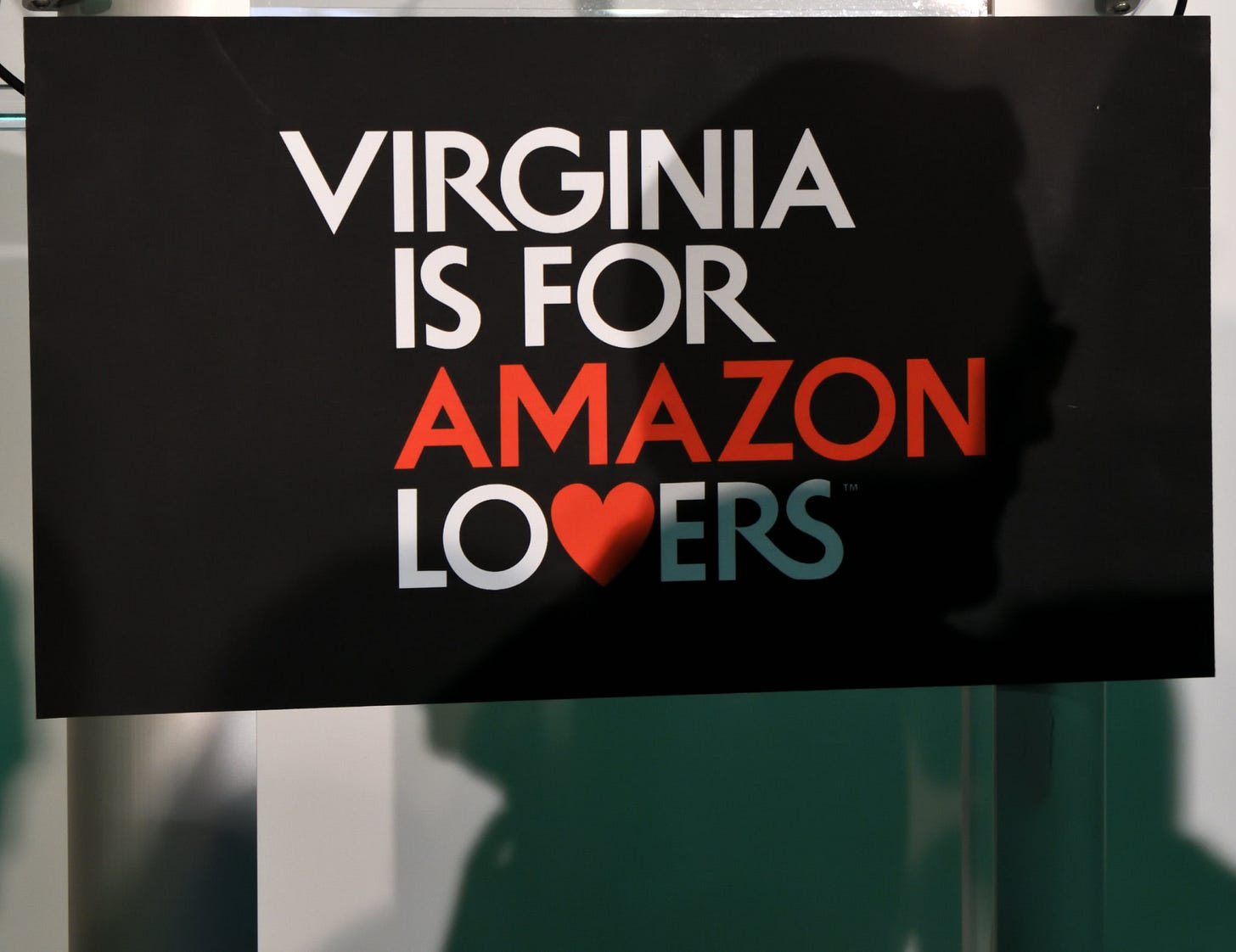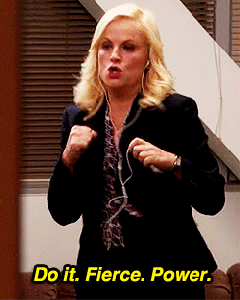Amazon's Top to Bottom Subsidy Scam
PLUS: A big win in New York State, and what you can do to help.

This is a special edition of Boondoggle that is being co-published with The Daily Poster, a grassroots-funded news organization. It’s my most complete look yet at the totality of Amazon’s subsidy scheme. I hope you like it, and hope you support both The Daily Poster and this newsletter in our efforts to hold corporations accountable.
In 2017, Amazon launched a much-hyped search for a new office, which it dubbed “HQ2,” setting off an unprecedented wave of city and state officials crafting incentive packages to win the corporation’s favor. More than 200 cities ultimately submitted bids, promising Amazon hundreds of millions, and in some cases billions, of public dollars in return for the supposed investment and job creation that hosting HQ2 would bring.
Many critics believed at the time that this supposedly open competition was rigged from the very beginning: Amazon executives knew where they wanted to go, but wanted to maximize the public funds they received and collect data on scores of cities in which they never intended to open a corporate office.
That view was bolstered when Amazon chose to split HQ2 between the New York and Washington, D.C., metro areas, placing itself in the world capital of finance and the nation’s capital, two places where it had significant interests that had nothing to do with incentive monies.
Further confirmation that the HQ2 search was a sham comes from journalist Brad Stone’s recently published book, Amazon Unbound. Stone reported that while Amazon’s selection committee did the work of assessing the various HQ2 bids and settled on Chicago, Raleigh, or Philadelphia, they were kiboshed by Amazon executives for ludicrous reasons.
For example, current Amazon CEO Jeff Bezos — who reportedly only made the HQ2 search so public because he was jealous of the subsidies Elon Musk received for his various business ventures, such as Tesla and SpaceX — was supposedly told by his “gut” that those finalist cities were no good. Incoming Amazon CEO Andy Jassy, meanwhile, didn’t want to go to Philadelphia because he’s a fan of the NFL’s New York Giants, bitter rivals with the Philadelphia Eagles.
Those reasons may be especially dumb, but they’re indicative of a far wider truth about Amazon that extends beyond its HQ2 search: The company wants to collect loads of public subsidies from communities all across the country as a way to build a competitive advantage over other large retailers and the small businesses on its platform. In order to receive those dollars, it’s sold local leaders a myth that subsidies are necessary to drive its expansion and influence its investment decisions, even though every action it takes proves that its subsidy drive is about power, not economics.
Wasted Public Subsidies
Overall, Amazon has collected more than $4 billion in subsidies from state and local governments dating back to 2000, according to data compiled by Good Jobs First. The bulk of the subsidies have been to build out its distribution network, the warehouses and distribution centers that hold the goods sold by Amazon and the many so-called third-party sellers who use the Amazon platform to hawk their wares.
In addition, The Intercept recently reported that Congress may create a special $10 billion bailout fund for Bezos’s space company, as Bezos gets ready to fly up to space himself.
Much like with HQ2, Amazon promises communities across the country — from major cities to tiny towns and hamlets — that giving the company tax breaks and other favors in exchange for new distribution facilities will boost local economies. But as with HQ2, those handouts have very little to do with where Amazon chooses to locate.
As Good Jobs First detailed on this set of maps, Amazon builds its distribution network where there is a concentration of Amazon Prime subscribers, residents with disposable income, and access to major transportation infrastructure such as highways and airports. Those all make good business sense: They enable Amazon to get goods faster to those with the most money to spend and the highest likelihood of spending it on Amazon’s platform. Public subsidies have little to do with the equation.
To prove that point, Amazon has recently built several distribution centers and warehouses with no public assistance at all: one in Nueces County, Texas; one in Tucson, Arizona; another in Danbury, Connecticut; one in Fort Bend County, Texas; and one in Visalia, California. Amazon didn’t draw much public attention to these developments, but by tracking local press reports, it’s possible to see that the corporation is taking subsidies where available, but not actually making them a prerequisite for its endless expansion.
The Danbury example is particularly instructive because, at about the same time, another Amazon facility in Windsor, Connecticut, received $8.8 million in public subsidies. What was the difference between the two Connecticut locations? Nothing, it seems, except the willingness of community leaders to pay.
Indeed, the divergent experiences of the chosen HQ2 cities illustrate that elected officials and taxpayers have far more power than they know. After a concerted outcry from residents and New York officeholders such as state Sen. Mike Gianaris and U.S. Rep. Alexandria Ocasio-Cortez, D-N.Y., Amazon pulled the plug on its HQ2 plan in New York. The corporation then quietly expanded operations in the Empire State anyway — because of course it wants to have a presence in such an important city.
Leaders in the D.C. suburbs in Northern Virginia, meanwhile, did not listen to the advocates and activists who said providing Amazon some $750 million in subsidies for HQ2 was a raw deal. The new office is expected to price at least 10,000 lower-income residents out of the area, a process that is already underway. (The proposed building, meanwhile, looks like a poop emoji.)
By handing taxpayer money to Amazon, local leaders are buying into a scam from top to bottom, and in the process harming their own bottom lines, their local businesses, and their local workers. The facts show Amazon doesn’t need your money. The company’s executives just want it, ask for it, and too often get it.
UPDATE (WITH A REQUEST): The bill to update New York’s antitrust laws that I mentioned in last week’s edition passed the New York State Senate on Monday. This is a huge deal! Here, again, is the explainer my colleague Matt Stoller and I wrote on the bill, as well as an interview Matt did with Sen. Mike Gianaris, its sponsor.
Now for the request part. The bill still has to pass New York’s Assembly, and the state legislative session ends tomorrow. So if you’re a resident of New York State, please call your Assembly Member’s office and ask them to ensure that this bill — which is Assembly Bill 1812A — receives a vote and is passed before they close up shop.
This is a huge opportunity to dramatically improve the ability to rein in corporate power in New York, and will hopefully serve as a model for other states to follow. So if you’re from New York, please do take just a minute to call your Assembly Member. It could make a big difference.
Thanks for reading this edition of Boondoggle. If you liked it, please take a moment to click the little heart under the headline or below. And forward it around to friends, family, or neighbors using the green buttons. Every click and share really helps.
If you don’t subscribe already and you’d like to sign up, just click below.
Finally, if you’d like to pick up a copy of my book, The Billionaire Boondoggle: How Our Politicians Let Corporations and Bigwigs Steal Our Money and Jobs, go here.
Thanks again!
— Pat Garofalo



